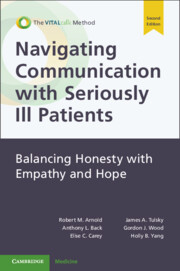Book contents
- Navigating Communication with Seriously Ill Patients
- Navigating Communication with Seriously Ill Patients
- Copyright page
- Dedication
- Reviews
- Contents
- Preface
- Acknowledgments
- 1 Taking Your Skills to the Next Level
- 2 Foundational Communication Skills
- 3 Talking about Serious News
- 4 Discussing Prognosis
- 5 Planning for the Future: Discussing What’s Important, Well Before a Crisis
- 6 Discussing Treatment Decisions
- 7 Between the Big Events
- 8 Goals of Care in Late-Stage Disease
- 9 Conducting a Family Conference
- 10 Dealing with Conflicts between Clinicians and Patients
- 11 Working Through Conflicts with Colleagues
- 12 When You’re Really Stuck
- 13 Talking about Dying
- 14 Cultivating Your Skills
- Index
- References
6 - Discussing Treatment Decisions
When You’re at a Crossroads
Published online by Cambridge University Press: 05 April 2024
- Navigating Communication with Seriously Ill Patients
- Navigating Communication with Seriously Ill Patients
- Copyright page
- Dedication
- Reviews
- Contents
- Preface
- Acknowledgments
- 1 Taking Your Skills to the Next Level
- 2 Foundational Communication Skills
- 3 Talking about Serious News
- 4 Discussing Prognosis
- 5 Planning for the Future: Discussing What’s Important, Well Before a Crisis
- 6 Discussing Treatment Decisions
- 7 Between the Big Events
- 8 Goals of Care in Late-Stage Disease
- 9 Conducting a Family Conference
- 10 Dealing with Conflicts between Clinicians and Patients
- 11 Working Through Conflicts with Colleagues
- 12 When You’re Really Stuck
- 13 Talking about Dying
- 14 Cultivating Your Skills
- Index
- References
Summary
Discussing treatment options is more complex than giving information and making a recommendation. Today, shared decision making includes patient access to the electronic medical record and internet searches, however patients still turn to their clinicians as the most important and trusted source. In addition to balancing information and emotion, clinicians need to take into account how involved patients wish to be in decision making. A roadmap for discussing treatment decisions is: 1. Prepare for the visit, 2. Frame the decision to be made, 3. Ask about decision-making preferences explicitly, 4. Adapt the discussion and recommendations based on patient decision-making preferences (shared decision making, clinician-led decision making, pros/cons), 5. Check for patient understanding, 6. Establish how the patient wants to proceed with the decision-making process. Take care with how statistics are presented and consider providing decision aides. Asking patients how they want to make decisions will help ground decisions in their values.
- Type
- Chapter
- Information
- Navigating Communication with Seriously Ill PatientsBalancing Honesty with Empathy and Hope, pp. 89 - 100Publisher: Cambridge University PressPrint publication year: 2024



